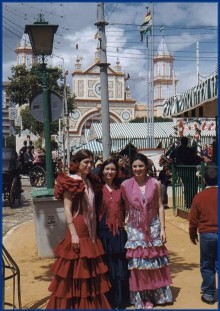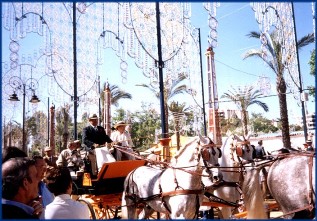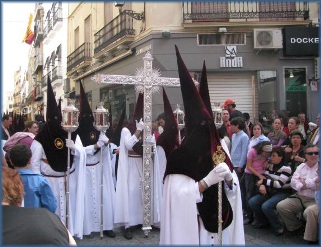FESTIVALS |
Festivals play a major role in Spanish life. They are eagerly awaited and planned well in advance. Each city and region has its own special fiesta, often in honor of a patron saint. Activities associated with fiestas include processions, fireworks, dancing, and the wearing of the regional costume, bullfights, and amusement attractions. |
Here are a few |
Three Kings Celebrations is an evening parade on January 5th. Often, on the eve of Three King's Day, the Christ child is placed in nativity scenes in local homes and stores. Men attired in Three Kings costumes ride on colorfully decorated floats & throw tons of candies to thousands of people lined up on the streets. Location: Pretty much all-Spanish towns |
Location: Cadiz; El Puerto de Santa Maria; Rota; Chipiona; San Lucar de Barremeda and Jerez de la Frontera |
|
Running of the Bulls, which takes place in the second week of July, is dedicated to Pamplona's Saint Fermin who was martyred when bulls dragged him through the streets. For over six centuries now, the Spanish have held gala festivals involving bulls, dancing and voluminous consumption of red wine. Pamplona, a small town in the northern part of Spain hosts the wildest and most famous of all these festivals -- La Fiesta De San Fermin -- which undoubtedly ranks as one of the most exciting and fun-filled weeks anywhere on earth. The celebration first gained world attention with Hemingway's classic, The Sun Also Rises. Today, thousands of people flock to Pamplona each year to be chased through the same streets by bulls. If you want to have a great time, go to Pamplona. Location: Pamplona |
"Ferias", take place from the end of April to end of May. The
importance and popularity of a given fair depends on the size of the town.
Not only the decoration, lighting of the fairgrounds, number of bullfights,
rides, shooting galleries and "casetas" (booths), but also the
idiosyncrasies of the local people and area wines are the determining factors
in gaining fame for certain fairs. Fair activity programs usuall y include
at least one bullfight. Late in the evening, after the bullfights, the
fair activities regain new energy and last until dawn. y include
at least one bullfight. Late in the evening, after the bullfights, the
fair activities regain new energy and last until dawn.
Location: Andalusia's cities La Tomatina, takes place on the last Wednesday of each August. It is one of the Spain's most popular summer festivals - the annual tomato-throwing festival. Participants pelted each other with overripe tomatoes, turning the streets of this eastern Spanish town into red, juicy pools. It started in the 1940s when children started throwing their lunch at each other one day in a downtown square, at a time when the region's tomato exports were starting to pick up. They met again the following year, this time pelting passers-by as well and giving birth to the tradition. Every August, on the last Wednesday of the month, Bunol becomes an all out tomato fight between 11am and 1pm. Location: Bunol |
 Horse
Fair, takes place late April/early
May. It is a week dedicated
to horses. Jerez is famous for raising the best quality horses in Spain.
Different competitions, including bullfighting on horseback, are held and
awards presented. It also features the annual evening gala of the famous
Andalucian Dancing Horses. Horse
Fair, takes place late April/early
May. It is a week dedicated
to horses. Jerez is famous for raising the best quality horses in Spain.
Different competitions, including bullfighting on horseback, are held and
awards presented. It also features the annual evening gala of the famous
Andalucian Dancing Horses.
Location: Jerez de la Frontera The Mercè
(patron saint of the city) is one of the most important
celebrations in Barcelona. The main event is on September 24th, although
various pageants, concerts and activities begin three days earlier. Three
of the most traditional events around the Mercé celebrations are: Location: Barcelona |
| San
Isidro, takes place in the second half of May, is in honor Madrid's
Patron Saint. The celebrations are accompanied by typical Madrid folklore,
including Fair and Dances that are organized on the meadow of San Isidro,
where the people of Madrid sing, dance and enjoy themselves next to the
Hermitage of their Patron Saint. There are also ballet and opera performances
as well as the traditional bullfights at the bullring of Las Ventas.
Location: Madrid |
Ferias and Fiestas de San Mateo takes place in September. For two weeks,
there is a fully organized program of concerts, parades, exhibitions,
bullfights and markets.
 Location: Salamanca "Semana Santa", takes place during Holy Week/Easter. There is Palm Sunday and Holy Week processions with a variety of colorfully decorated floats depicting Christ's Crucifixion, as well as other historically Christian statues. The participants in the processions dress in special robes and hoods, which add color and somberness to the event. Location: Andalusia |
 Carnaval Celebrations takes place the week before Lent.
The Spanish
word "Carnaval" means "farewell to flesh." It is
a period of feasting and revelry just before Lent. The church often refers
to it as the "Devil's Feast." Most Americans know this celebration
by the name "Mardi Gras", as it is called in New Orleans. Celebrations
include wild masquerade dances, parades, fireworks, pinatas, and elections
of nymphs, burning of witches, singing contests, street-singing parties,
patio decorations and costume contest.
Carnaval Celebrations takes place the week before Lent.
The Spanish
word "Carnaval" means "farewell to flesh." It is
a period of feasting and revelry just before Lent. The church often refers
to it as the "Devil's Feast." Most Americans know this celebration
by the name "Mardi Gras", as it is called in New Orleans. Celebrations
include wild masquerade dances, parades, fireworks, pinatas, and elections
of nymphs, burning of witches, singing contests, street-singing parties,
patio decorations and costume contest.
